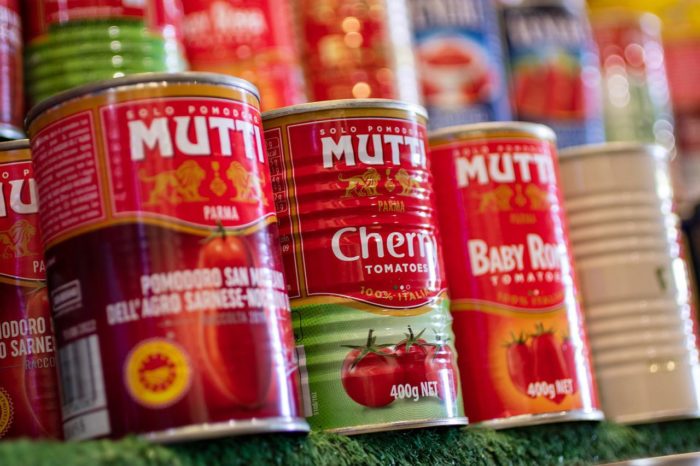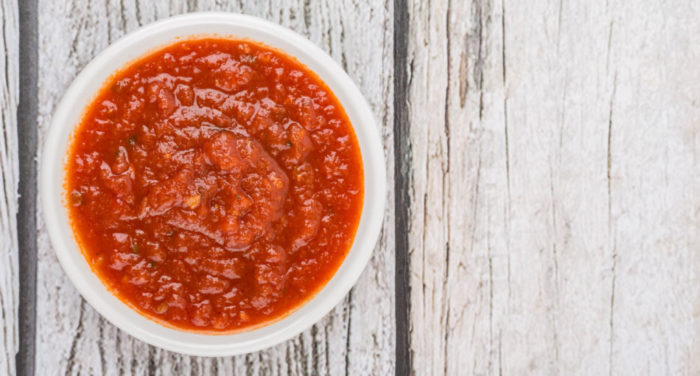
Need of a tomato sauce substitute? We’ve got you covered with suggestions and ideas here.
Tomato sauce is a versatile ingredient that finds use in a whole lot of recipes. Italian cuisine uses it generously, though other cuisines aren’t far behind. So, it can get a bit troublesome when you find yourself in a situation where you can’t (or don’t want to) use it for a recipe.
Thankfully, the versatility and ubiquity of tomatoes in cuisine means that there are plenty of options that are as good.
Creativity, resourcefulness, and skills, all have their part to play in culinary goodness. When you use substitutes, try to mold the recipe or the substitute in a way that the dish you prepare feels authentic.
Let’s see what our options are for substituting tomatoes.
Consider These Tomato Sauce Substitutes For Your Use
1. Tomato Paste
Tomato paste is practically just a step away from being sauce and that’s a distance you can cover while cooking. There are two points to note when using paste in place of tomato sauce.
- The paste is stronger.
- There are no herbs or spices in tomato paste.
Since both these aspects are easy to handle, tomato paste is the best substitute for tomato sauce. The exact ratio for replacements depends on the brand or the specific paste you use. As a rule of thumb, use only half the quantity of paste compared to sauce.
Diluting the paste with water helps with the consistency, volume, and moisture of the recipe. In the same vein, if you want to skip adding moisture to the dish, don’t add water. Throw in some spices to make it more aromatic
2. Ketchup
Tomato sauce and ketchup seem very similar, especially if you buy them packaged. The larger difference between both comes from some additions, like vinegar. Tomato Ketchup may contain vinegar, but tomato sauce should never have vinegar.
So, if you use this substitution, keep note of the taste change vinegar might bring. It will also affect texture, amongst other things. Usually, this makes ketchup a good substitute for savory recipes.
Use ketchup in a 1:1 ratio for the sauce. Use it freely in lasagna, chili sauces, or similar dishes. Ketchup will caramelize as it cooks, opening more possibilities for its uses. Use it for savory dishes but steer clear from using it in sweet recipes.
3. Canned Tomatoes

Got a can of tomatoes lying around? Well, use them as a substitute.
The cans are usually full of liquid, start by straining it off so you’re left with tomatoes or diced tomatoes. While you could use these tomatoes as is, it won’t be the best option. So, give them a whirr in the blender or mixer. Throw in some spices, herbs, and a pinch of sugar as well.
Once you’re done blending, you’ll be left with a watery mix that’s similar to tomato sauce, but weaker. Use two spoons of this mix if the recipe calls for one spoon of the sauce. If the extra moisture presents a problem, adjust the water requirements in other steps of the recipe.
Another option is to reduce this mix of canned tomatoes and herbs etc. on a medium flame. Let the extra liquid evaporate until the mix takes a consistency similar to sauce. Use this to replace the sauce in a 1:1 ratio.
4. Tomato Soup
Now here’s an interesting option, but it works in a pinch. Canned tomato soup usually matches tomato sauce in consistency. However, it isn’t as strong and doesn’t contain the same herbs and spices.
If the recipe calls for one cup of sauce, use 10 oz of soup. That also brings up the need to adjust water in other parts of the recipe to prevent it from getting watery.
Another point of adjustment is the seasoning. Consider adding some garlic, herbs, and spices to get the soup closer in flavor to the sauce it’s replacing.
5. Spaghetti Sauce or Pasta Sauce

Tomato is a prime ingredient in pasta sauce and spaghetti sauce. So, these options are viable as a substitution, even if they’re not the top choice. There is plenty of added flavor and spices in these sauces, so some adjustments could be necessary. You can use these replacements in a 1:1 ratio.
6. Tomato Juice
Fresh tomato juice is a treat. Control the urge of making a Bloody Mary, and you can use it as a replacement for tomato sauce. There’s going to be a fair amount of water with this pick, so be prepared to cut off or reduce water at other points in the recipe.
For replacement, you’ll need twice the amount of tomato juice compared to sauce. Replace each part of the sauce with two parts of the juice (1:2 ratio). This substitution isn’t suitable for recipes that don’t use much water. But it can work well for recipes that use a fair amount of water.
7. Beets And Carrots
Need an alternative free of tomatoes? Beets and carrots can do the trick. It’s an odd substitute and will take some effort getting right. This substitute combo is more a path for experienced chefs, rather than new cooks.
To use this, simmer beets and carrots in oil with some garlic. Once they’re soft enough, either use a potato masher or a blender to get the consistency right. This option will change the color and texture of your dish, though the taste can stay close enough to the original.
The beet-carrot combo can replace sauce in a 1:1 ratio.
8. Marinara Sauce

Often used for pizza and chili, Marinara Sauce is also a good replacement. Be careful when using it, as the strong seasoning and flavor may end up changing the taste of your dish. But it can come in handy for spicy dishes and similar.
9. Pureed Bell Peppers
Don’t want to use tomatoes and don’t want to sacrifice the color either? Pureed bell peppers can do just that. Roast the peppers in oil with some garlic. Follow this by putting them in a blender to get the consistency right.
Dilute the pureed bell peppers with water to get the required consistency as tomato sauce. You can use this replacement in a 1:1 ratio in the recipes.
Making Tomato Sauce At Home
DIY tomato sauce is a convenient and fruitful endeavor. There is some intricacy involved, so let’s see how it can all work out.
Ingredients
- Fresh tomatoes (about five pounds)
- Salt
- Herbs like basil and bay leaf, but you can add more depending on your preference
- Olive oil – 1 to 2 tablespoons
- Half a clove of garlic
- Onion (optional)
- A few chopped carrots (optional)
Step 1: Preparing The Tomatoes
It’s important to remove the seeds and skin from tomatoes to make a good sauce. There’s no easy way to do this. Prepping the tomatoes is going to be most of the manual labor you put in to make the sauce.
It’s possible to use tomato paste in the recipe instead of fresh tomatoes and get around this problem. However, using tomatoes is the preferable option.
There are a few ways to skin the tomatoes. Place them in a hot bath for a few minutes, then peel and core them. It might be useful to carve a (not too deep) ‘X’ mark on the tomato skin before putting them in a hot bath. It helps to peel off the skin easily.
Chop the tomatoes and they’re ready for the sauce. While the recipe will need more manual intervention, most of the hard work is done by this point.
Step 2: Let’s Get Cooking
Add the olive oil to a large pot and set it to medium heat. As the oil gets hot, add all other ingredients. Since the juice of tomatoes is included, it’s not necessary to add any water. But if you feel that the sauce could benefit from some water, feel free to add it.
If the mix starts to boil, reduce the heat to simmer. Cover the pan and stir the mix occasionally for about 20 minutes. At this point, the vegetables (optional) you added will soften. By this point, the tomatoes will give out water too and the mix will take on a liquid form.
Step 3: Reduce The Sauce
Now is the time to think of consistency. Let the ingredients simmer until the sauce reaches its desired consistency. It might take 30 minutes to 2 hours or even more. The volume of the sauce will halve during this time. Since we used whole tomatoes, expect it to take longer.
Step 4: Getting The Consistency Right
Is the sauce more chunky than you prefer? Use a spatula to crush some of the chunks. If you want to be more thorough with removing the chunks, use a potato masher.
Once it reaches the right consistency, the sauce is ready. Generally, five pounds of tomato will yield somewhere between 2-3 cups of sauce. Let it cool down, pour it into an airtight container, and place it in the freezer.
Working With Tomato Paste To Get Your Sauce Substitute
Tomato paste as a substitute is good for use right off the shelf. That’s easy, but let’s get cooking to flavor it up and make it resemble sauce closely.
How To Make Tomato Sauce From Tomato Paste
Tomato paste is a very convenient ingredient for our use here. Most of the work (as explained in the recipe above) is already done, so all that’s necessary is to get the flavoring and consistency right.
- Mix equal parts of tomato paste and water.
- Blend until thoroughly mixed.
This creates a very simple version of the sauce. However, it usually contains herbs and spices, so we’ll have to do more to make our sauce authentic.
- Add some olive oil to a pan.
- Add a small amount of onion and garlic and cook until they’re soft.
- You may also add some herbs and spices at this point.
- Add the tomato-paste water mix to the pan and let it heat through.
Tomato sauce made from tomato paste is now ready. Easy and quick! Doing the effort to add these extra herbs means you get a better tasting, more authentic sauce from the paste.
Replace Tomato Sauce With Tomato Paste
Here’s the first point to remember: tomato paste is more concentrated than sauce and has no herbs. The smart way is to dilute paste and use a lower amount as compared to sauce.
So, if a recipe calls for one cup of sauce, use half a cup of paste mixed with half a cup of water. It may be necessary to adjust the recipe for the lack of herbs and spices in the paste
What Alternative Will I Use For The Sauce?
Choosing the right tomato sauce substitute will often lead you to tomato paste. Adding a few herbs will liven things up and make it a better substitute. However, if paste isn’t available, take a look at the other options on this list to find another suitable alternative.